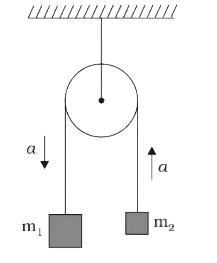A body A of mass M while falling vertically downwards under gravity brakes into two parts, a body B of mass 13 M and a body C of mass 23 M. The center of mass of bodies B and C taken together shifts compared to that of body A towards
depends on the height of breaking
does not shift
body C
body B
The correct Answer is:B
Initially, acm=g, vertically downwards After breaking of body A
Fext=0, So, acm=0
Since, vcm= Constant ⇒Δycm=0
∴ Centre of mass of the bodies B and C does not shift.
Topper's Solved these Questions
- BOOK - MODERN PUBLICATIONCHAPTER - SYSTEMS OF PARTICLES AND ROTATIONAL MOTIONEXERCISE - COMPETITION FILE ( OBJECTIVE TYPE QUESTIONS MULTIPLE CHOICE QUESTIONS (with more than one correct answer) )35videos
SYSTEMS OF PARTICLES AND ROTATIONAL MOTION
- BOOK - MODERN PUBLICATIONCHAPTER - SYSTEMS OF PARTICLES AND ROTATIONAL MOTIONEXERCISE - COMPETITION FILE (OBJECTIVE TYPE QUESTIONS (ASSERTION REASON TYPE QUESTIONS) )10videos
SYSTEMS OF PARTICLES AND ROTATIONAL MOTION
- BOOK - MODERN PUBLICATIONCHAPTER - SYSTEMS OF PARTICLES AND ROTATIONAL MOTIONEXERCISE - COMPETITION FILE (OBJECTIVE TYPE QUESTIONS (MULTIPLE CHOICE QUESTIONS) (MULTIPLE CHOICE QUESTIONS WITH ONLY ONE CORRECT ANSWER) )67videos
SYSTEMS OF PARTICLES AND ROTATIONAL MOTION
- BOOK - MODERN PUBLICATIONCHAPTER - PHYSICAL WORLD EXERCISE - Revision exercises (Long answer questions)6videos
PHYSICAL WORLD
- BOOK - MODERN PUBLICATIONCHAPTER - THERMAL PROPERTIES OF MATTEREXERCISE - CHAPTER PRACTICE TEST15videos
THERMAL PROPERTIES OF MATTER
Similar Questions
A body A of mass 3 . 0 kg and a body B of mass 10 kg are dropped simultaneously from a height of 14 . 9 m Calculate
their momentaView SolutionTwo bodies of masses m1andm2(<m1) are connected to the ends of a massless cord and allowed to move as shown in figure. The pulley is both massless and frictionless. The acceleration of the centre of mass is (m1−m2)n(m1+m2)2g. Find the value of n.
 View Solution
View Solution
Knowledge Check
- Question 1 - Select One
On a straight line passing through the foot of a tower, two points C and D are at distances of 4 m and 16 m from the foot respectively. If the angles of elevation from C and D of the top of the tower are complementary, then find the height of the tower.
ABody CBBody BCDepends on height of breakingDDoes not shift - Question 2 - Select One
Position of center of mass of a body
ALies always at the geometrical center.BLies always inside the body.CLies always outside the body.DMay lie within or outside the body. - Question 3 - Select One
A body falling vertically downwards under gravity breaks in two parts of unequal masses. The centre of mass of the two parts taken together shifts horizontally towards
Aheavier pieceBlighter pieceCdoes not shift horizontallyDdepends on the verical velocity at the tiem of breaking
A body falling vertically downwards under gravity breaks in two parts of unequal masses. The centre of mass of the two parts taken together shifts horizontally towards
View SolutionA body A mass m1 exerts a force on another body B of mass m2 . If the acceleration of B be a2 , then the acceleration (in magnitude) of A is
View SolutionA body of mass M moves with velocity v and collides elasticity with another body of mass m(M>>m) at rest , then the velocity of the body of mass m is
View SolutionA body of mass m is taken to the bottom of a deep mine. Then
View SolutionFrictional force is greater for a body of _____ mass as compared to a body of lesser mass
View Solution

